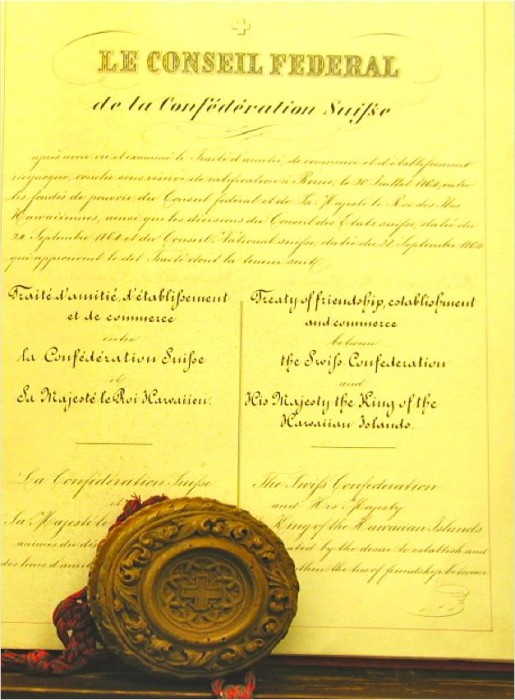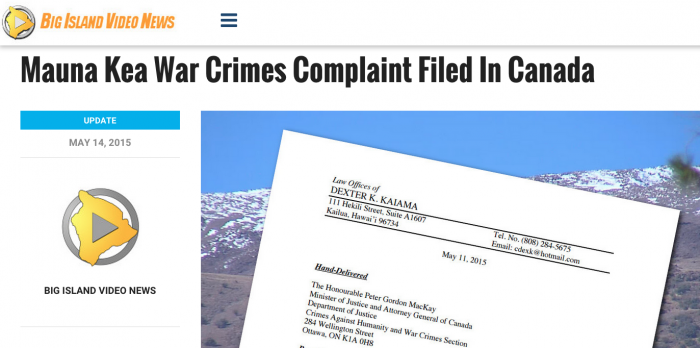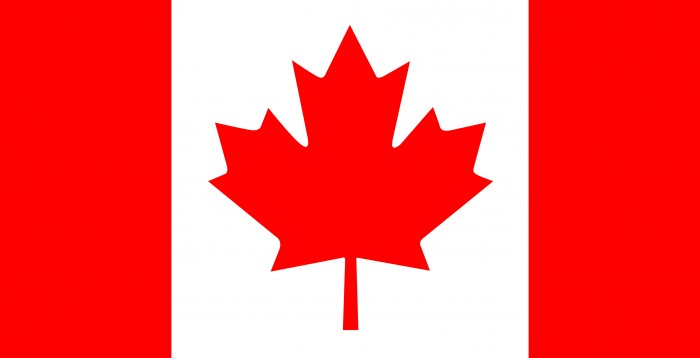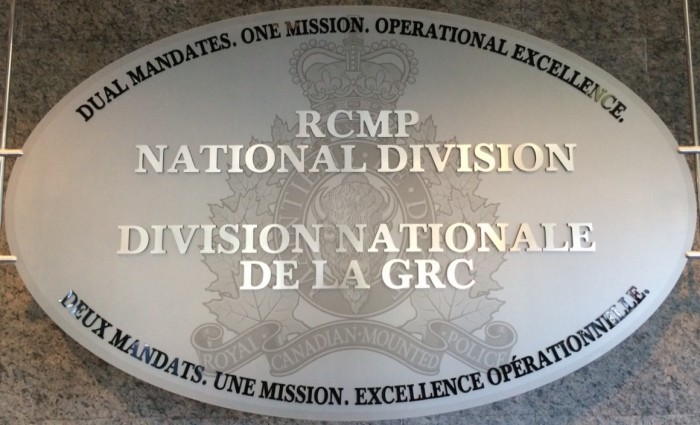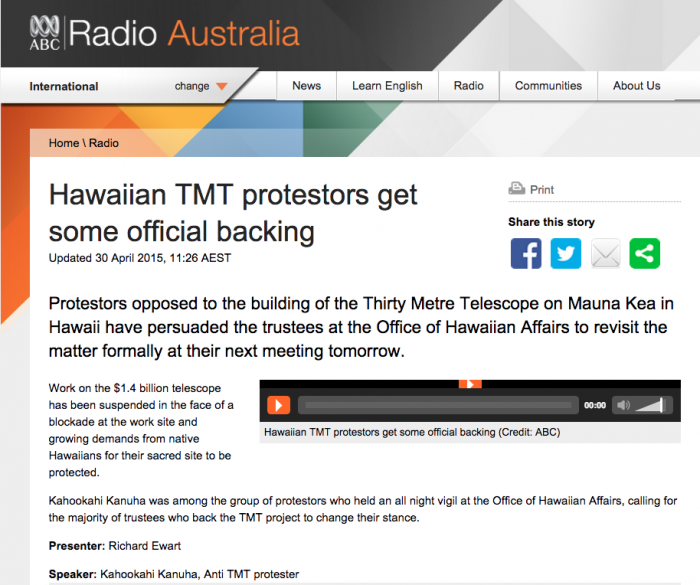Author Archives: Hawaiian Kingdom
Hawai‘i Island: La Ho‘iho‘i Ea (Restoration Day) Celebration
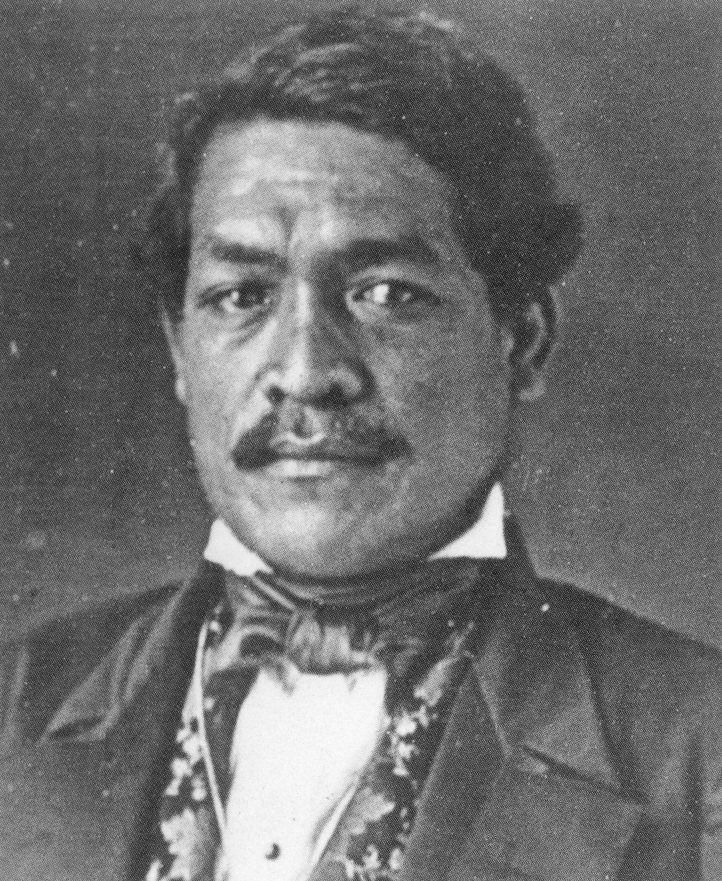 In the summer of 1842, Kamehameha III moved forward to secure the position of the Hawaiian Kingdom as a recognized independent state under international law. He sought the formal recognition of Hawaiian independence from the three naval powers of the world at the time—Great Britain, France, and the United States. To accomplish this, Kamehameha III commissioned three envoys, Timoteo Ha‘alilio, William Richards, who at the time was still an American Citizen, and Sir George Simpson, a British subject. Of all three powers, it was the British that had a legal claim over the Hawaiian Islands through cession by Kamehameha I, but for political reasons the British could not openly exert its claim over the other two naval powers. Due to the islands prime economic and strategic location in the middle of the north Pacific, the political interest of all three powers was to ensure that none would have a greater interest than the other. This caused Kamehameha III “considerable embarrassment in managing his foreign relations, and…awakened the very strong desire that his Kingdom shall be formally acknowledged by the civilized nations of the world as a sovereign and independent State.”
In the summer of 1842, Kamehameha III moved forward to secure the position of the Hawaiian Kingdom as a recognized independent state under international law. He sought the formal recognition of Hawaiian independence from the three naval powers of the world at the time—Great Britain, France, and the United States. To accomplish this, Kamehameha III commissioned three envoys, Timoteo Ha‘alilio, William Richards, who at the time was still an American Citizen, and Sir George Simpson, a British subject. Of all three powers, it was the British that had a legal claim over the Hawaiian Islands through cession by Kamehameha I, but for political reasons the British could not openly exert its claim over the other two naval powers. Due to the islands prime economic and strategic location in the middle of the north Pacific, the political interest of all three powers was to ensure that none would have a greater interest than the other. This caused Kamehameha III “considerable embarrassment in managing his foreign relations, and…awakened the very strong desire that his Kingdom shall be formally acknowledged by the civilized nations of the world as a sovereign and independent State.”
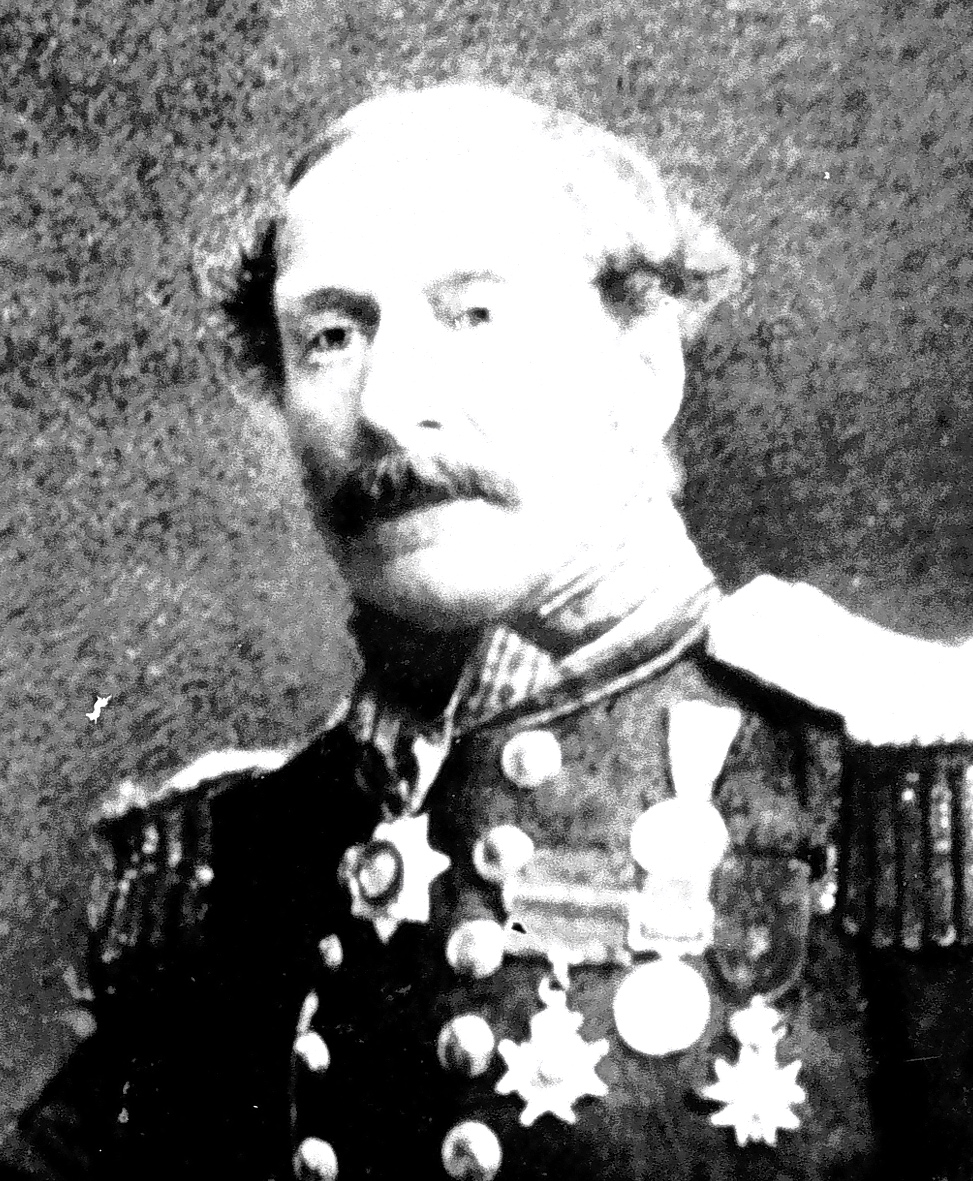 While the envoys were on their diplomatic mission, a British Naval ship, HBMS Carysfort, under the command of Lord Paulet, entered Honolulu harbor on February 10, 1843, making outrageous demands on the Hawaiian government. Basing his actions on complaints made to him in letters from the British Consul, Richard Charlton, who was absent from the kingdom at the time, Paulet eventually seized control of the Hawaiian government on February 25, 1843, after threatening to level Honolulu with cannon fire. Kamehameha III was forced to surrender the kingdom, but did so under written protest and pending the outcome of the mission of his diplomats in Europe. News
While the envoys were on their diplomatic mission, a British Naval ship, HBMS Carysfort, under the command of Lord Paulet, entered Honolulu harbor on February 10, 1843, making outrageous demands on the Hawaiian government. Basing his actions on complaints made to him in letters from the British Consul, Richard Charlton, who was absent from the kingdom at the time, Paulet eventually seized control of the Hawaiian government on February 25, 1843, after threatening to level Honolulu with cannon fire. Kamehameha III was forced to surrender the kingdom, but did so under written protest and pending the outcome of the mission of his diplomats in Europe. News 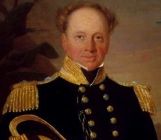 of Paulet’s action reached Admiral Richard Thomas of the British Admiralty, and he sailed from the Chilean port of Valparaiso and arrived in the islands on July 25, 1843. After a meeting with Kamehameha III, Admiral Thomas determined that Charlton’s complaints did not warrant a British takeover and ordered the restoration of the Hawaiian government, which took place in a grand ceremony on July 31, 1843. At a thanksgiving service after the ceremony, Kamehameha III proclaimed before a large crowd, ua mau ke ea o ka ‘aina i ka pono (the life of the land is perpetuated in righteousness). The King’s statement became the national motto.
of Paulet’s action reached Admiral Richard Thomas of the British Admiralty, and he sailed from the Chilean port of Valparaiso and arrived in the islands on July 25, 1843. After a meeting with Kamehameha III, Admiral Thomas determined that Charlton’s complaints did not warrant a British takeover and ordered the restoration of the Hawaiian government, which took place in a grand ceremony on July 31, 1843. At a thanksgiving service after the ceremony, Kamehameha III proclaimed before a large crowd, ua mau ke ea o ka ‘aina i ka pono (the life of the land is perpetuated in righteousness). The King’s statement became the national motto.
The envoys eventually succeeded in getting formal international recognition of the Hawaiian Islands “as a sovereign and independent State.” Great Britain and France formally recognized Hawaiian sovereignty on November 28, 1843 by joint proclamation at the Court of London, and the United States followed on July 6, 1844 by a letter of Secretary of State John C. Calhoun. The Hawaiian Islands became the first Polynesian nation to be recognized as an independent and sovereign State.
The ceremony that took place on July 31 occurred at a place we know today as “Thomas Square” park, which honors Admiral Thomas, and the roads that run along Thomas Square today are “Beretania,” which is Hawaiian for “Britain,” and “Victoria,” in honor of Queen Victoria who was the reigning British Monarch at the time the restoration of the government and recognition of Hawaiian independence took place.
Video: Kanaka Express Show on Hawai‘i’s Prolonged Occupation
https://vimeo.com/129756298
Kanaka Express Host Kale Gumapac interviews Dr. Keanu Sai, Attorney Dexter Ka‘iama and Professor Kaleikoa Ka‘eo. The three being interviewed share their work regarding the prolonged occupation of the Hawaiian Kingdom and the movement to ultimately bring the American occupation to an end. The show was filmed at the Akaku studio in Kahului, Maui on May 20, 2015.
Hawaiian Kingdom Blog Named Best of Law Blogs
On June 5, 2015, YouBlawg has twittered the Hawaiian Kingdom blog (@HKSpokesperson) to be the best of the law blogs. YouBlawg is based in the United Kingdom.

From its website: “YouBlawg is a law blog or “blawg” founded by former lawyer Gavin Ward in 2010 and is designed for law firms, lawyers, law students and other legal professionals to contribute their own legal knowledge and opinions on legal news, with the aim of helping consumers and businesses to find valuable legal information and connect them with the best lawyer for them.”
Alleviating the Confusion: Swiss Criminal Procedures In Light of Civil Law Tradition
What people may not know is that Switzerland’s criminal procedures are very different from the United States. Switzerland operates under a “civil law tradition” while the United States operates under a “common law tradition” that came from the English common law because the original thirteen States of the United States were formerly British colonies. In contrast, the civil law has codes and the common law does not. Civil law countries provide legal codes that explain all matters that can be brought before the courts, the applicable procedure of criminal investigations, the punishment for crimes, and trial. Switzerland’s codes are the Swiss Criminal Code (SCC) and the Swiss Criminal Procedure Code (SCPC). Common law countries do not provide comprehensive codes, but rather rely on numerous statutes and precedence set by decisions of judges, which is called stare decisis.
A very good compare and contrast of the two legal systems can be found in Dr. Vivienne O’Connor’s publication “Common Law and Civil Law Traditions.”
Another contrast is that in common law countries, judicial proceedings are adversarial between the prosecutor and the defendant, with the judge merely serving as the referee. In civil law countries, the proceedings are not adversarial and the judges play an integral role in both the criminal investigation stage as well as the trial stage. Under Swiss law (Article 17, SCPC), as in most civil law countries, judges can conduct criminal investigations, in addition to the police and the prosecutor. In Switzerland, these judges are called investigating magistrates and have more expanded powers than the prosecutor or police. Once an investigating magistrate concludes the criminal investigation he/she can seek indictments, and then the evidence and interviews that were conducted would be turned over to another judge or set of judges who will preside over the criminal trial. Jury trial is a common law tradition and not civil law. There are no jury trials in civil law countries, which includes Switzerland.
According to Dr. O’Connor, “International treaties and conventions also are sources of law in civil law countries. Most civil law countries are ‘monist’ meaning that when the country ratifies a treaty, it automatically becomes part of domestic law. This means that a judge can automatically apply it and a party in court can rely on international law in proceedings. In some countries, the judge can declare a national law or provision to be invalid if it conflicts with an international treaty or convention that the country has ratified.”
The Swiss Criminal Code provides for the Federal Attorney General to conduct criminal investigations for war crimes, but their decisions are subject to review by the “objections authority” of the Swiss Federal Criminal Court if someone is objecting to “the procedural acts and decisions [of an investigating magistrate, prosecutor or police] not subject to appeal (Article 20, SCPC).” This was the role the objection chambers of the Swiss Federal Criminal Court held in the case of Mr. Kale Gumapac and the unnamed Swiss citizen who were alleging that war crimes were committed against them in the Hawaiian Islands.
What is the significance of the Swiss Federal Criminal Court’s reciting of Gumapac’s invoking his rights as a Hawaiian subject under the 1864 Hawaiian-Swiss treaty, “which wasn’t cancelled”? At first, it may appear that the Court was merely reciting Gumapac’s position that the treaty wasn’t cancelled, but did Gumapac state or even imply that it was he who was stating that the treaty wasn’t cancelled, or was it the three-judge panel that made that conclusion. The Court in making specific reference to Gumapac’s amended complaint dated January 22, 2015, stated, “that, in addition, by way of a letter dated January 22, 2015, [Dr. Keanu] Sai, in the name of Kale Kepekaio Gumapac…contacted the office of the Federal Attorney General and requested that criminal proceedings against Josef Ackermann…, the former CEO of Deutsche Bank National Trust Company…be opened and in this connection invoked rights deriving from Art. 1 of the friendship treaty between the Swiss Confederation and the then Hawaiian Kingdom of July 20, 1864, which has not been cancelled.”
In order to determine whether it was Gumapac who made this statement or the Court we need to look at what was stated in the amended complaint.
Gumapac, by his attorney-in-fact Dr. Sai, amended the original complaint dated December 7, 2014. The amended complaint states that Gumapac’s “initial complaint was based on universal jurisdiction, but in light of the fact that Josef Ackermann, who served as the Chief Executive Officer for Deutsche Bank when the war crimes were committed against [Gumapac], is a Swiss citizen, Mr. Gumapac is amending his complaint to include active personality jurisdiction and is invoking his rights as a Hawaiian subject under Article 1 of the 1864 Hawaiian-Swiss Treaty, which provides: “Hawaiians shall be received and treated in every canton of the Swiss Confederation, as regards their persons and their properties, on the same footing and in the same manner as now or may hereafter be treated, the citizens of other cantons.”
Active personality jurisdiction is when the accused is a Swiss citizen, and universal jurisdiction is where the alleged war crime was committed outside of Swiss territory by non-Swiss citizens against non-Swiss citizens.
The amended complaint then follows, “Therefore, according to Articles 118 and 119 of the Swiss Criminal Procedure Code (S-CPC), Mr. Gumapac is expressly declaring that he has suffered grave harm and respectfully demands that your office initiate an immediate investigation into the war crime of pillaging committed by Josef Ackermann being a Swiss citizen residing within the territory of the Swiss Confederation.” Gumapac made no statement that the treaty wasn’t cancelled, but rather was operating on the premise that the treaty remained binding on the Swiss authorities that were obligated to treat Gumapac in the same manner as Swiss citizens are treated in any of the cantons.
The question of whether or not a treaty has or has not been cancelled is a question of fact and not a question of law. The treaty itself will provide the process by which it can be terminated. For the Swiss treaty, Article VIII requires notice of intention to terminate by either of the contracting countries, and once the other country receives the notice of termination the treaty will terminate in 12 months. In the absence of any notice of termination, the “treaty will continue obligatory.”
Another way a treaty can be cancelled is if one of the countries that is a party to the treaty, ceases to exist as a country under international law. Without the existence of one of the parties there can be no treaty, because a treaty, by definition, is an agreement between two or more States. Therefore, if the Hawaiian Kingdom were annexed by the United States under international law, it would have consequently cancelled the Hawaiian-Swiss Treaty and replaced it with the U.S.-Swiss Treaty. This was specifically stated in the 1898 U.S. Congressional joint resolution of annexation, which read, “The existing treaties of the Hawaiian Islands with foreign nations shall forthwith cease and determine, being replaced by such treaties as may exist, or as may be hereafter concluded, between the United States and such foreign nations.”
A joint resolution of Congress has no force and effect beyond U.S. territory and, as such, cannot have the power to cancel the treaty between Switzerland and the Hawaiian Kingdom. In other words, the only way to annex Hawai‘i and to cancel its treaty with Switzerland was for the United States to have a treaty with Hawai‘i that would have the effect of merging Hawai‘i into the United States. Only then would it have the effect of canceling the treaty with Switzerland. However, there is no treaty, but rather only a unilateral Congressional action.
When the Swiss Federal Criminal Court stated that the Hawaiian-Swiss treaty “wasn’t cancelled,” it was not a conclusion of law, but rather a conclusion of fact that supported Gumapac’s invoking of his rights under Article 1 of the treaty. In his report dated February 3, 2015, the Prosecutor, himself, also made the same conclusion regarding the status of the treaty. The report (German) (English translation) stated, “On January 22, 2015, Kale Kepekaio GUMAPAC confirmed in writing the accusations against Joseph ACKERMANN and in addition pointed out his rights stemming from Art. 1 of the friendship treaty between the SWISS CONFEDERATION and the then HAWAIIAN KING of July 20, 1864, which was never cancelled.”
Again this statement that the treaty was never cancelled was the Prosecutor’s conclusion and not Gumapac’s. Both the Prosecutor and the three-judge panel made the statement that the Hawaiian-Swiss Treaty wasn’t cancelled. Therefore, there is no dispute between the Swiss authorities and the war crime victims as to the treaty’s continued existence.
When the Court received the objection to the decision made by the Prosecutor on April 8, 2015, the President of the Objections Chamber ordered, by letter dated April 9, 2015, that the Prosecutor turn over all records of his investigation. The order stated, “In the matter mentioned above, a complaint against your decision not to engage of February 15, 2015 has been received at the Federal Criminal Court. You are requested to furnish the Federal Criminal Court right away with the records established in the abovementioned matter (including documents of receipt) with an index of the records.” This is a clear example of the civil law tradition where judges are involved in a criminal investigation. In common law countries such as the United States, there is no judicial oversight of a prosecutor’s decision to conduct a criminal investigation.
The three-judge panel of the Federal Criminal Court’s Objection Chambers would not have restated the allegations of war crimes in its April 28, 2015 decision unless the alleged war crimes met the statutory definition of war crimes under Swiss law. If not, it would have been deemed frivolous in this preliminary stage of the investigation and the Swiss Criminal Court would have dispensed with the criminal investigation and make no mention of the allegations. Nowhere in the decision did the three-judge panel state or even imply that the Prosecutor’s decision was going to be upheld.
Even more stunning, the decision specifically named Josef Ackermann, former CEO of Deutsche Bank, and officials of the State of Hawai‘i—Governor Neil Abercrombie, Lieutenant Governor Shan Tsutsui, Director of Taxation Frederik Pablo, and Deputy Director of Taxation Joshua Wisch. Under the civil law tradition, the decision by the Objections Chamber of the Federal Criminal Court is a part of the criminal investigation stage of these proceedings.
For the purposes of Swiss law, a war crime is defined as an international armed conflict, as between two or more States, even when occupation of the other State takes place without any armed resistance. The Hawaiian Kingdom was occupied by the United States on August 12, 1898, when the United States was waging war in the Spanish colonies of the Philippines and Guam. This was very similar and analogous to the German occupation of Luxemburg from 1914-1918 as it was waging war against France during World War I. Both the American occupation of Hawai‘i and the German occupation of Luxemburg took place without armed resistance.
From the decision (German) (translation to English), it appeared that the three-judge panel was prevented from reversing the Prosecutor’s decision because of a technicality, which was failure to submit the objection to the Court within the 10-day period allowed by law. In this case, Swiss law (Article 20, SCPC) allows the objections authority of the Swiss Federal Supreme Court’s Criminal Law Section to accept an objection to a decision made by “courts of the first instance,” which, in this case, is the three-judge panel of the Swiss Federal Criminal Court. Again, here is another example under the civil law tradition of having another level of judges overseeing a criminal investigation.
On May 29, 2015, the Clerk’s office of the objections authority of the Swiss Supreme Court’s Criminal Law Section accepted the objection, and assigned it case number 6B_563/2015. The Clerk’s office stated that the proceedings are against the Federal Criminal Court, Objections Chamber, as well as the Office of the Swiss Federal Attorney General. It further stated, “Possible procedural orders, as far as necessary, will follow.”
Swiss Federal Criminal Court Recognizes Switzerland’s Treaty with the Hawaiian Kingdom was Never Cancelled and Implies Hawai‘i was Never Annexed
In a cogent and thoughtful decision the Swiss Federal Criminal Court Objections Chamber recently issued two important and profound statements as to the sovereignty of the Hawaiian Kingdom. Although the Court held that, the filing was untimely and no longer appropriate in a Swiss Federal Criminal Court. The case has now been moved to the Criminal Law section of the Swiss Federal Supreme Court in Lausanne. These procedural issues do not diminish the two critical statements the Court made about the status of Hawai‘i.
Download Federal Criminal Court Decision (German) (translation to English)
First, the Court stated that the 1864 Treaty between Switzerland and the Hawaiian Kingdom was never canceled—and is still in effect. Second, the Court identified certain officials and former officials of the State of Hawaii by name as possibly subject to a continuing investigation as to alleged war crimes. Although the Court ruled the filing was untimely, the Court did provide a means by which the plaintiffs could obtain review in the Swiss Supreme Court.
Professor Williamson B.C. Chang, a law professor at the University of Hawai‘i at Manoa, called this statement by the Swiss Court “an extraordinary assessment of the status of Hawaii with enormous ramifications. It confirms my own views that the United States never acquired the Hawaiian Islands, either in 1898 or thereafter.”
Professor Chang also stated, “Indeed, the fact that the statement was made, given that there was no need to make such a statement, renders the statement even more significant. If Hawai‘i had been annexed then all treaties of the Hawaiian Kingdom would have become void.”
The U.S. congressional joint resolution that purportedly annexed Hawai‘i in 1898 during the Spanish-American War stated, “The existing treaties of the Hawaiian Islands with foreign nations shall forthwith cease and determine, being replaced by such treaties as may exist, or as may be hereafter concluded, between the United States and such foreign nations.” Obviously the Swiss Court was not swayed by the language of the joint resolution of Congress, and therefore concluded that the Hawaiian-Swiss Treaty was not cancelled.
To Professor Chang, the statement of the Swiss Court directly contradicts the official position of the United States as currently maintained by the United States Department of State, Office of the Historian, on its official website, “The McKinley Administration also used the [Spanish-American] war as a pretext to annex the independent state of Hawaii… At McKinley’s request, a joint resolution of Congress made Hawaii a U.S. territory on August 12, 1898.”
Second, and equally significant, the Objections Chamber of the Swiss Federal Criminal Court specifically named present and former State of Hawai‘i officials as well others who are defendants and alleged war criminals. Again, the Swiss Criminal Court dismissed on the grounds of untimeliness, nevertheless, the Court held that plaintiffs had a pathway to bring their claims before the Swiss Supreme Court. Thus, the actions of the Defendants will continue to be examined before that Court.
The naming of names is significant because the Court had no need to identify these individuals. Those named are the former Chief Executive Officer of Deustch Bank, Joseph Ackerman, the former Governor of the State of Hawai‘i, Neil Abercrombie, current Lieutenant Governor Shan Tsutsui, former Director of the Department of Taxation, Frederik Pablo, and former deputy Director, Joshua Wisch.
The Swiss criminal action began when the Swiss Attorney General received a war crimes report by Dr. Keanu Sai, as the attorney-in-fact for Mr. Kale Gumapac, a Hawaiian subject, who was a victim of war crimes in December 2014. Dr. Sai also represents another war crimes victim who is a Swiss citizen residing in the Hawaiian Islands, but his name is kept confidential for safety concerns. Prosecutor Andreas Muller from the Attorney General’s Competence Centre for Terrorism and Competence Centre for International Criminal Law initiated a war crimes investigation.
Prosecutor Muller abandoned the investigation on February 3, 2015, and Dr. Sai objected to the Swiss Federal Criminal Court Objections Chamber seeking an order to direct the Prosecutor to complete the investigation and proceed with the prosecution.
The Objections Chamber concluded they were prevented from hearing the objection because of a previous court case that stated if a private courier, such as FedEx, was used to submit documents to a court it would only recognize the date it was received and not the date it was postage marked. There was a 10-day period to object after Dr. Sai received the Prosecutor’s decision and report on March 23, 2015. The deadline to object was April 2, 2015. Although, the objection was sent via FedEx on April 1, 2015, it did not arrive at the Objections Chamber until April 8.
“When I received the Prosecutor’s report I needed to get it translated into the English language in order to draft the objection,” said Dr. Sai. “Once I got the translation, I wrote the objection, which was 12 pages, and then I proceeded to get it translated into German before sending it off. After the translation was completed on April 1, I immediately went to FedEx.” At the request of Dr. Sai, the Clerk of the Federal Criminal Court forwarded the case to the Federal Supreme Court in Lausanne.
In a letter (German) (translation to English) to Dr. Sai from the Criminal Law Section of the Federal Supreme Court dated May 21, 2015, the Clerk of the Court stated the Supreme Court will accept the case if Dr. Sai would “explicitly state by June 5, 2015 that the Federal Supreme Court should accept and treat [his] submission as an objection in criminal matters.” As directed, Dr. Sai drafted a letter dated May 24, 2015 (German) (translation to English), which stated “I hereby explicitly state that the Federal Supreme Court should accept and treat my submission in the above case as an objection in criminal matters pursuant to the provisions of the Federal Supreme Court Act (BGG) of June 17, 2005.” Dr. Sai’s letter arrived in Switzerland by a personal courier and mailed to the Supreme Court through the Swiss postal service on May 28, 2015, which met the deadline of June 5.
Big Island News Video: Kanuha Talks About Delivering War Crimes Complaint To Canada
HILO – On May 14, it was reported that a war crimes complaint was filed in Canada in connection with the planned Thirty Meter Telescope project on Mauna Kea. Since then, Kaho‘okahi Kanuha – one of the two individuals that made the international trip to deliver the complaint – returned to Hawaii. Kanuha is a spokesperson for the group that is blocking TMT from the summit of Mauna Kea. We spoke to him in Hilo on Saturday afternoon, May 16th.
The complaint was drafted by Kanuha’s attorney Dexter Kai’ama. Kanuha was accompanied by Dr. Keanu Sai, who drafted a detailed War Crimes Report at the request of Kai’ama. Shortly after the headline grabbing arrests that took place on the mountain on April 2, Big Island Video News spoke to both men.
One of the 31 arrested on Mauna Kea was Kanuha. Since then, his role in the movement has transformed as he takes on speaking engagements across the islands, although his position in regards to the TMT has not changed.
Since this interview was conducted, TMT announced Canada as a full partner in the project.
KITV 4 News: TMT Opponent Kaho‘okahi Kanuha files Formal War Crimes in Canada
Click here to view the KITV News clip that aired on Wednesday May 13, 2015.
HONOLULU—And there are no signs of slowing down for TMT opponents. In Canada earlier today, they filed formal war crimes complaints with the Canadian Justice Department.
Activist Kaho‘okahi Kanuha says the charges are for desecration of property, unlawful confinement, and being denied the right to a fair trial. The last two relates to the arrests of 31 protestors who blocked construction of the thirty-meter telescope.
Kaho‘okahi Kanuha in Canada stated: “We’re working off of the fact that Hawai‘i was never legally annexed by the United States of America. This has gotten international attention, world-wide attention, and the ramifications of the actions taking place on the mountain, are very, very, they’re huge.”
Kanuha says that filing initiates a preliminary inquiry into their complaints. He says if the Canadian Justice Department finds “probable cause”—it will launch a criminal investigation.
Big Island Video News: Mauna Kea War Crimes Complaint Filed In Canada
Canada and War Crimes
Canada is a constitutional monarchy. The British Monarch is the Head of State and the Canadian Prime Minister is the Head of Government. Canada received its dominion status in 1867 under the Constitution Act enacted by the British Parliament. This Act provided self-government for Canada while the British Monarch remained the Head of State represented by a Governor General. Today the Constitution Act of 1867 forms the basis of Canada’s constitution.
Since 1867, Canada’s treaties with other countries required the countersignature of a British Minister. The first treaty Canada entered into on its own was with the United States in 1923—the Halibut Treaty. Prior treaties that Great Britain entered into with other countries before 1923 applied to Canada if it mentioned the treaties application to British dominions as well as to the United Kingdom.
When the Hawaiian Kingdom entered into a Treaty of Friendship, Commerce and Navigation in 1851 with the British, the treaty applied to the United Kingdom and the British Monarch’s dominions, which included Canada. The Hawaiian-British Treaty would also apply to other countries that achieved dominion status, which today is referred to as realm status, include Antigua and Barbuda, Australia, The Bahamas, Barbados, Grenada, Jamaica, New Zealand, Papua New Guinea, St. Christopher and Nevis, St. Lucia, St. Vincent and the Grenadines, Solomon Islands, and Tuvalu. All realm countries recognized the British Monarch as the Head of State.
The Hawaiian-British Treaty is permanent and has no provision for cancellation. Other treaties the Hawaiian Kingdom entered into that have no provisions to terminate and are permanently binding include Denmark (1846) and Japan (1871).
In 1985, Canada established the Commission of Inquiry on War Criminals “to conduct such investigations regarding alleged [Nazi] war criminals in Canada, including whether any such persons are now resident in Canada and when and how they obtained entry to Canada.” The Commission made recommendations on how to bring war criminals to justice proposed amendments to laws to accomplish this.
By virtue of these recommendations, specialized war crime sections were established in the Department Justice, the Royal Canadian Mounted Police (RCMP), and the Citizenship and Immigration Canada. In 1998, the War Crimes Program was established as an interdepartmental initiative between these three departments. In 2003, the Canada Border Services Agency joined the three.
On December 18, 1998, Canada signed the International Criminal Court’s (ICC) Rome Statute that reinforced Canada’s commitment to enact further legislation to criminalize war crimes, crimes against humanity, and genocide. In 2000, Canada enacted the Crimes Against Humanity and War Crimes Act that authorized Canadian authorities to prosecute war crimes committed on Canadian territory and outside of Canada. If the war crimes are committed on Canadian territory, the jurisdiction is territorial. If the war crimes are committed abroad by a Canadian the jurisdiction is active personality principle, and if the victim of the war crime is Canadian the jurisdiction is passive personality principle. If the war crimes committed abroad have no direct connection to Canada, the jurisdiction is universal principle.
The ICC exercises universal jurisdiction with the primary responsibility to prosecute is with countries that signed the Rome Statute, but for cases that will be prosecuted by the ICC, Canada amended its Mutual Legal Assistance in Criminal Matters Act (1985) in 2015 to allow Canadian authorities to assist the ICC Prosecutor with their own investigation of persons and the gathering evidence in Canada.
 The RCMP National Division’s Sensitive and International Investigations unit is responsible criminal investigations for war crimes. The Sensitive and International Investigations “is tasked with investigating the activities of suspected war criminals who have sought safe haven in Canada. These investigations require strong collaboration between the RCMP and our national and international partners, the ability to adapt to various foreign legal systems while respecting their customs and laws, and bringing these convicted war criminals to justice by denaturalizing, deporting or extraditing them.”
The RCMP National Division’s Sensitive and International Investigations unit is responsible criminal investigations for war crimes. The Sensitive and International Investigations “is tasked with investigating the activities of suspected war criminals who have sought safe haven in Canada. These investigations require strong collaboration between the RCMP and our national and international partners, the ability to adapt to various foreign legal systems while respecting their customs and laws, and bringing these convicted war criminals to justice by denaturalizing, deporting or extraditing them.”
This unit works together with the Department of Justice’s Crimes Against Humanity and War Crimes Section. War crimes can be reported to both agencies and both are headquartered in Ottawa, capital city of Canada.
War Crimes on Mauna Kea Reported to Canadian Federal Authorities
 OTTAWA, CANADA – On May 13, 2015, attorney Dexter Ka‘iama reported war crimes of unlawful confinement, deprivation of a fair trial, and destruction of public property to the Department of Justice’s Crimes against Humanity and War Crimes section and to the Royal Canadian Mounted Police (RCMP) National Division’s Sensitive and International Investigations on behalf of his client, Mr. Kaho‘okahi Kanuha. War crimes were alleged to have been committed by TMT International Observatory, LLC, (TMTIO), which has a Canadian partner, the Association of Canadian Universities for Research in Astronomy. Canada’s government also recently committed $250 million dollars for the construction of the thirty-meter telescope by TMTIO on Mauna Kea.
OTTAWA, CANADA – On May 13, 2015, attorney Dexter Ka‘iama reported war crimes of unlawful confinement, deprivation of a fair trial, and destruction of public property to the Department of Justice’s Crimes against Humanity and War Crimes section and to the Royal Canadian Mounted Police (RCMP) National Division’s Sensitive and International Investigations on behalf of his client, Mr. Kaho‘okahi Kanuha. War crimes were alleged to have been committed by TMT International Observatory, LLC, (TMTIO), which has a Canadian partner, the Association of Canadian Universities for Research in Astronomy. Canada’s government also recently committed $250 million dollars for the construction of the thirty-meter telescope by TMTIO on Mauna Kea.
Ka‘iama requested Dr. Keanu Sai, a political scientist, to draft a War Crimes Report to accompany the complaint so Canadian authorities can understand the context of why war crimes are being committed in the Hawaiian Islands. The report affirmatively answers four fundamental questions that underlie Ka‘iama’s complaint: first, whether the Hawaiian Kingdom existed as an independent State and a subject of international law in the nineteenth century; second, whether the Hawaiian Kingdom continues to exist as an independent State and a subject of International Law, despite the illegal overthrow of its government by the United States on January 17, 1893; third, whether war crimes have been committed in violation of international humanitarian law; and, fourth, whether the Canadian Government is capable of investigating and prosecuting war crimes that occur outside of its territory.
Download the War Crimes Complaint.
Download the War Crimes Report.
Due to a court appearance on Maui, Ka‘iama was unable to accompany Kanuha to meet with the Canadian authorities. In his stead, Dr. Sai, who is Ka‘iama’s law office’s expert consultant on these matters, accompanied Kanuha. In a letter to the Canadian authorities, Ka‘iama stated, “Dr. Sai is perhaps the foremost qualified expert to answer any questions you may have regarding the case as well as the circumstances of why the Hawaiian Islands are currently under an illegal and prolonged occupation by the United States since the Spanish-American War, 1898, being an international armed conflict as defined under common Article 2 of the 1949 Geneva Conventions.”
 “We met with two Constables who were criminal investigators of the RCMP’s Sensitive and International Investigations unit at their headquarters,” said Kanuha. “They fully understood what we were saying about war crimes and they took it very seriously. At first they were puzzled because they assumed Hawai‘i was a part of the United States, but Dr. Sai was able to explain why and how we were occupied since the Spanish American War. Dr. Sai even lightened things up when he asked them if they ever saw the movie Matrix, and after they both said yes, he jokingly told them that they just took the red pill and now they know about Hawai‘i’s occupation. Dr. Sai even told the Constables that Keanu Reeves, a Canadian citizen who played Neo in the Matrix, was his cousin.”
“We met with two Constables who were criminal investigators of the RCMP’s Sensitive and International Investigations unit at their headquarters,” said Kanuha. “They fully understood what we were saying about war crimes and they took it very seriously. At first they were puzzled because they assumed Hawai‘i was a part of the United States, but Dr. Sai was able to explain why and how we were occupied since the Spanish American War. Dr. Sai even lightened things up when he asked them if they ever saw the movie Matrix, and after they both said yes, he jokingly told them that they just took the red pill and now they know about Hawai‘i’s occupation. Dr. Sai even told the Constables that Keanu Reeves, a Canadian citizen who played Neo in the Matrix, was his cousin.”
The war crimes were reported in accordance with the Canadian Crimes Against Humanity and War Crimes Act (2000) and international humanitarian law. Ka‘iama stated, “I am filing this complaint, on behalf of my client, Mr. Chase Michael Kaho‘okahi Kanuha, a Hawaiian subject and protected person, for the war crime of deprivation of liberty when he, along with thirty other individuals, was unlawfully arrested and temporarily detained on April 2, 2015, in the taking of protective measures to prevent the war crime of destruction of public property during occupation to be carried out by TMT International Observatory, LLC, (TMTIO) upon the summit of Hawai‘i’s largest mountain Mauna a Wakea, also known as Mauna Kea. Additionally, my client is reporting the war crimes of destruction of public property during occupation committed in the building and erecting of the following thirteen observatories:
- University of Hawai‘i Institute for Astronomy’s UH telescope built in 1970;
- NASA’s Infrared Telescope Facility built in 1979;
- CFHT Corporation’s Canada-France-Hawai‘i Telescope built in 1979;
- UKIRT’s United Kingdom Infrared Telescope built in 1979;
- East Asian Observatory’s James Clerk Maxwell Telescope built in 1987;
- Caltech Submillimeter Observatory’s telescope (10-meter) built in 1987;
- National Radio Astronomy Observatory’s Very Large Baseline Array radio-telescope antennas built in 1992;
- M. Keck Observatory’s Keck I telescope built in 1993;
- M. Keck Observatory’s Keck II telescope built in 1996;
- National Astronomical Observatory of Japan’s Subaru Telescope built in 1999;
- Gemini Observatory’s Gemini Northern Telescope built in 1999;
- Smithsonian Astrophysical Observatory and the Academia Sinica Institute of Astronomy and Astrophysics of Taiwan’s Submillimeter Array built in 2002;
- University of Hawai‘i at Hilo’s UH Hilo Educational Telescope built in 2010.”
In the complaint, Ka‘iama invoked his client’s rights under the 1851 Hawaiian-British Treaty with the filing of this complaint. Article VIII provides, “The subjects of either of the contracting parties, in the territories of the other, shall receive and enjoy full and perfect protection for their persons and property, and shall have free and open access to the courts of justice in the said countries, respectively, for the prosecution and defense of their just rights; and they shall be at liberty to employ, in all causes, the advocates, attorneys or agents of whatever description, whom they may think proper; and they shall enjoy in this respect the same rights and privileges as native subjects.” The treaty, among other things, provides reciprocal rights to the subjects of the Hawaiian Kingdom and to the subjects of Her Majesty in all of her dominions, which includes Canada.
Download the 1851 Hawaiian-British Treaty
The treaty is perpetual and has no provisions for termination, except for termination of articles 4, 5, and 6 that apply to duties and trade. According to Dr. Sai, “the treaty continues to be binding on Her Britannic Majesty in right of Canada or any of its provinces.” In 1893, the Hawaiian Kingdom maintained a Legation in London, a Consul General in Toronto (Ontario), and Consulates in Montreal (Québec), Belleville (Ontario), Kingston (Ontario), Rimouski (Québec), St. Johns (Newfoundland and Labrador), Yarmouth (Nova Scotia), Victoria (British Columbia), and Vancouver (British Columbia).
After Ka‘ima stated, “In accordance with the principle that war crimes shall not be treated with impunity, and also pursuant to §702.1 of Canada’s Unit Guide (1990), which notes that the Geneva Conventions ‘impose an obligation on all nations which have ratified them to search for and try all persons who committed or ordered to be committed grave breaches of the Conventions,’” he requested “that an enquiry be instituted by the RCMP’s Sensitive and International Investigations concerning the alleged violations of the 1949 Geneva Convention, IV. And, if after careful review the violations have been established, I call upon the Canadian authorities to put an end to the violations and punish those responsible without any possible delay.”
Kanuha said, “This is not a conflict between culture and science, but rather on procedures that have not complied with international law and the law of occupation. If Hawai‘i is legally a part of the United States then there are no war crimes, but if Hawai‘i is not then we are forced to deal with the ramifications of this new reality and war crimes that have been committed on Mauna a Wakea. This has been a learning process for me and for many others as well. I never thought stopping the building of the thirty-meter telescope would be at the international level.”
CONTACT: Dexter Ka‘iama, Esquire
Phone: (808) 284-5675
Email: cdexk@hotmail.com
ABC Radio Australia: Hawaiian TMT protestors get some official backing
San Diego Free Press: Protecting Mauna Kea – History for Haoles

Will Faulk, a journalist for the San Diego Free Press, has consented to the reprint of his article that was published online today April 29, 2015.
In the first essay of my Protecting Mauna Kea series, I made a mistake. I wrongfully described the ongoing, illegal American occupation of Hawai’i as an “annexation.”
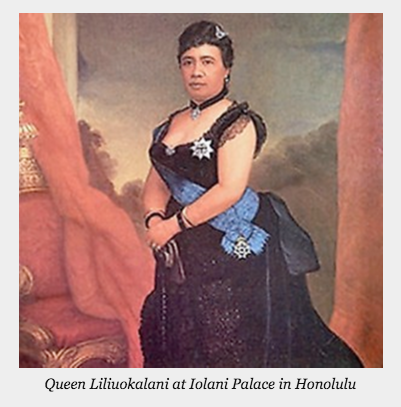
Hawaiian friends of mine pointed this out to me and gave me a thorough history lesson. I was referred to documents, books, and websites that tell the truth. For the last several days, I’ve been reading everything I can on the subject.
The more I read, the more convinced I become not only that the Thirty Meter Telescope project lacks any legal right to build on Mauna Kea, but that international law, indeed American law itself, demands that the United States end it’s occupation of Hawai’i.
I have two hopes for this piece. First, I want to give a history lesson for haoles. “Haole” is the Hawaiian word for white person. I am specifically directing this lesson at white settlers – at haoles – because the first thing haoles can do is understand the history of violence we benefit from.
This history lesson will demonstrate that the current regime controlling Hawai’i is illegitimate and as such has no authority to enforce the construction of the TMT on Mauna Kea.
Second, I want to relieve Hawaiians from the responsibility of educating haoles. Hawaiians have no responsibility to educate us. As a white settler hoping to stand in true solidarity with Hawaiians, I am upset with myself for the mistake. I have seen how frustrating it can be for a movement when valuable time must be spent coaching well-meaning settlers along.
I want to be clear: I am not advocating for a “call-out” culture on the front lines of resistance where resisters perpetually attack each other for their choice of words. Many of us must go through our personal experiences unlearning the lies we are taught and this takes time. The dominant culture, of course, does an excellent job lying. That’s why it’s the dominant culture.
But, I am saying that settlers need to take responsibility for educating other settlers. Leaving education to oppressed classes, forcing them to do the work of spreading consciousness, is a form of oppression in itself.
Before I begin, it is necessary to explain that this essay represents my opinions and my personal perspective of Hawaiian history stemming from the research I’ve done and been directed to. I am not a spokesperson for the Hawaiian people, neither am I spokesperson for the Mauna Kea protectors. I understand that there is no One True History, but I refuse to abide by the relativism I see perpetuating around me.
The complexity of a situation does not signify a lack of meaning. Rather, the complexity of a situation – especially ones with real, physical consequences – demands that we grapple with information to take a stand. As the world disintegrates before our eyes, I see too many people mired in the neutrality their belief in the relative nature of reality produces.
Make no mistake, if the construction of the TMT project results in the spill of hazardous chemicals in the largest freshwater aquifer on the Island of Hawai’i – a very real possibility – there will be very real consequences for life on the Island.
***
Milan Kundera famously stated the “struggle against oppression is the struggle of memory against forgetting.” I have found this to be shockingly true learning the history of Hawai’i. It is my belief that haoles have forgotten – or never knew – the history of Hawai’i. If we did not forget, there would be more of us supporting the Mauna Kea protectors and supporting true Hawaiian sovereignty.
What have we forgotten?
It starts centuries ago when Hawaiians first arrived in Hawai’i. Over the centuries, Hawaiians developed a culture based on ecological balance that included communal land tenure. I am very self-conscious that my attempts to explain a complex culture that existed for centuries before the arrival of Europeans would amount to so much generalization. I cannot possibly do the Hawaiian culture justice in a short essay, but so many discussions of Hawaiian history begin with the arrival of Captain Cook in 1778 erasing Hawaiian history pre-European contact.
There are always those that will accuse me of romanticizing Hawaiian culture, who will say “all human cultures are inherently destructive.” I do not mean to romanticize Hawaiian culture and it simply is not true that all human cultures are inherently destructive. We know the Hawaiian culture before 1778 had it’s own problems, but wide-scale ecological collapse was not one of them. In this era of total environmental destruction, we would do well to empower cultures who lived in balance with their land base.
From 1826 until 1893, the United States government recognized the independent Kingdom of Hawai’i including full, complete diplomatic relations with the Hawaiian government. For all intents and purposes, the United States viewed Hawai’i as a nation just like Mexico, Canada, or Great Britain. In fact, the United States entered into treaties involving navigation and commerce with Hawai’i in 1826, 1842, 1849, 1875, and 1887.

Then, in January, 1893, John L. Stevens, an American agent in Hawaii (his official title was United States Minister), conspired with non-Hawaiians and members of the U.S. Navy to overthrow the Hawaiian government. On January 16, 1893, Stevens and armed US naval personnel invaded Hawai’i and positioned themselves next to Hawaiian governmental buildings including Iolani Palace to intimidate Queen Liliuokalani. Queen Liliuokalani, under threats of bloodshed, yielded her authority to the government of the United States – NOT Stevens’ provisional government – until the time the United States would undo the actions of its representatives in Hawai’i.
Grover Cleveland was the president in 1893 and he initiated an investigation into the actions of Stevens and his cronies while calling for the restoration of the Hawaiian monarchy. The investigation concluded that Stevens and other US officials in Hawaii had abused their authority and had engaged in “an act of war.”
Still, the provisional government sought annexation in Congress, but was unable to rally the support of 2/3 of the Senate needed for annexation. So, on July 4, 1894, the provisional government that had forcibly invaded and overthrown the Kingdom of Hawai’i, declared itself the Republic of Hawai’i.
In 1896, William McKinley replaced Grover Cleveland as president. Using the excuse of the Spanish-American war and the need for a naval base in the Pacific, McKinley and the Senate began to entertain the notion of annexing Hawai’i, again.
In 1897, the Hawaiian people delivered a massive petition where nearly 90% of Hawaiians alive at the time declared their desire not to become part of the United States of America. Unable to secure a treaty of annexation, Congress passed a joint resolution titled “the Newlands Resolution” on July 7, 1898.
The illegality of this joint resolution is one of the most important things to understand about Hawaiian history. This resolution had no legal basis, had no validity, and was possible simply because of the armed might of the United States.
The resolution has no legitimate basis because laws passed by Congress have no authority internationally. Congress can only pass laws that apply within the United States.
Hawaiian legal scholar Dr. Keanu Sai explains it better than I can in his blog-article “International Law Prevents Construction of the Thirty Meter Telescope” when he writes, “The underlying problem that Congressmen at the time knew was that no law of Congress can have any force and effect beyond the borders of the United States. In other words, the United States could no more annex the Hawaiian Islands by passing a domestic law, than it could annex Canada today by passing a law.”
As part of the Newlands Resolution, the Republic of Hawai’i passed 1,800,000 acres of what had been crown, government, and public lands of the Kingdom of Hawai’i to the control of the United States. Included in this land is Mauna Kea. Through the acquisition of Mauna Kea in this way, the State of Hawai’i has leased land on Mauna Kea for the TMT’s construction. But, an illegal state giving land acquired illegally can only give – you guessed it – an illegal lease.
Of course, you don’t have to take my word for this history, because all of these facts were already admitted and apologized for by Congress on November 23, 1993. You can read their apology here.
***
So, can you see why we cannot call the occupation of Hawai’i an annexation? No treaty of annexation was ever signed. “Annexation” implies consent on the part of those annexed and clearly the Hawaiian people never consented.
To take this even deeper, the term “annexation” hides the truth, softens the reality that Hawai’i was invaded while the invaders still seek to assert dominance over Hawai’i. To use the term “annexation” is to forget and forgetting clears the wayfor oppression.
There’s something, though, that bothers me about all this. How can the American government and the American people after learning this history, after admitting the wrongs done to Hawai’i still allow something like the TMT project to happen? I think the answer is that learning the history is only the first small step. Knowing the history, we must act.
One of the intentions behind my writing is to try to understand how so many people can recognize problems in the world and then fail to act to solve those problems. I am a haole, so I can only speak as a haole, and I believe too many haoles settle for pointing out their privilege while the more important work involves undermining the forces that grants them that privilege over others in the first place. The history is clear. Hawaiians are being wronged. Now, we need to act.
U.S. Constitutional Law and Customary International Law for Territorial Annexation
To develop an informed position on current issues in Hawaiʻi, such as the TMT (Thirty Meter Telescope) standoff on Mauna Kea, it is important to have an accurate understanding of the legal status of Hawaiʻi.
The purpose of this article is to address common misconceptions people have regarding territorial annexation as it relates to the Constitution of the United States and customary international law.
www.archives.gov/exhibits/charters/constitution_transcript.html
In Article I, Section 8 of the U.S. Constitution, the enumerated powers of Congress are domestic. Specifically, there is no enumerated power for annexation of foreign territory.
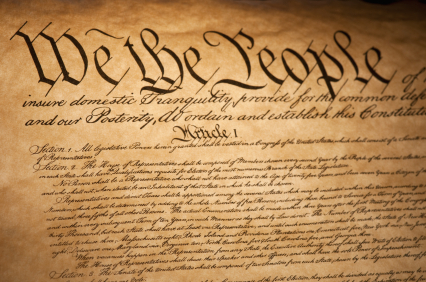
From Article II, Section 2 of the U.S. Constitution, regarding the President and Senate:
“He shall have Power, by and with the Advice and Consent of the Senate, to make Treaties, provided two thirds of the Senators present concur”
This power was used by the United States to enter 9 treaties of cession, annexing 56 out of 58 acquired territories, over a period of 168 years (1783-1951). This is the self-evident pattern of customary international law regarding territorial annexation, followed consistently by the United States throughout its history.
The Indian Appropriation Act of 1871 and the Island of Palmas arbitration in 1925 legally prevented this power from being used for annexation of American Sāmoa. There were two failed attempts, in 1893 and 1897, to use this power for annexation of Hawaiʻi, both of which were due to less than two thirds approval of the Senate.
The context of Article IV, Section 3, of the U.S. Constitution, is clearly domestic:
“New States may be admitted by the Congress into this Union; but no new State shall be formed or erected within the Jurisdiction of any other State; nor any State be formed by the Junction of two or more States, or Parts of States, without the Consent of the Legislatures of the States concerned as well as of the Congress.”
This power was used prematurely to admit Texas as a State in 1845 following two failed attempts, in 1837 and 1844, to pass a treaty of annexation for Texas in the U.S. Senate. The preliminary admission of Texas as a State in 1845 was followed by constitutional annexation of Texas as a Territory in 1848 through the Treaty of Guadalupe Hidalgo.
Therefore, since the Newlands Resolution claimed to annex Hawaiʻi as a Territory in 1898, and not admit it as a State, Texas is an invalid precedent. Furthermore, all 49 of the United States, including Texas, have a treaty of cession, while Hawaiʻi does not. This makes Hawaiʻi an unprecedented historical anomaly in violation of customary international law for territorial annexation, that in turn provides the evidence through which the U.S. constitution is interpreted.
88 out of 90 members of the U.S. Senate in 1898 opposed annexation of Hawaiʻi by joint resolution, because they held that it was unconstitutional in the context of customary international law, since Texas failed to provide a valid precedent. (youtu.be/yC4v0k0wd0Y)
The historical data for customary international law regarding territorial annexation, followed by the USA throughout its history, does not substantiate constitutional annexation of Hawaiʻi to the United States via joint resolution of U.S. Congress in 1898. This alleged annexation is an outlier in the data set—9 treaties annexing 56 territories in 168 years, plus the cession by American Sāmoa—that stands alone without precedent, both before and after the Newlands Resolution.
The provision in the U.S. Constitution for territorial annexation by a supermajority of the U.S. Senate is unequivocal when interpreted through this complete data set for customary international law. This is the appropriate context which must be included in any assessment of the claim of that Hawaiian sovereignty has been transferred to the United States.
Today, the typical American is oblivious to this complete data set regarding annexation of territory by the United States. However, this is not because access is restricted to these data, but due to generations of being indoctrinated by propaganda to the contrary. Therefore, instead of investigating the data, and interpeting it objectively, the typical American accepts the assumption that Hawaiʻi is the “50th State” as a foregone conclusion.
Hence, as will undoubtedly be demonstrated in comments on social media reacting to this article, Americans (and Americans-at-heart) will insist that Texas was annexed by joint resolution and not the Treaty of Guadalupe Hidalgo, since this underpins their belief that Hawaiʻi was annexed by joint resolution.
This unchallenged chain of assumptions, in turn, is a major factor underlying the belief that the TMT project has been legally approved for construction under American laws. However, by a score of 57 to 1, the data provided by customary international law fails to support the alternative hypothesis that the Hawaiian territory was annexed to the United States. In turn, these data invalidate the administration of U.S. laws in the Hawaiian territory.
Conversely, the data fails to reject the null hypothesis that the Hawaiian State has not been extinguished from its territory. Therefore, it cannot be concluded from customary international law that Hawaiʻi is part of the United States. Since occupation exists in the absence of annexation, and since both are mutually exclusive, the USA is in Hawaiʻi and not the other way around. In other words, Hawaiʻi is not part of the United States—nor has it ever been—without a treaty of cession.
Consequently, construction of the TMT would be classified as a war crime under international law through “extensive destruction and appropriation of property, not justified by military necessity and carried out unlawfully and wantonly,” which is one of the grave breaches specified in the 1949 Geneva Conventions.
Data Set & References: goo.gl/d6Ra2B
Author Bio
 Keokani Marciel is a lifelong aloha ʻāina (Hawaiian patriot) and kanaka ʻōiwi (aboriginal Hawaiian) who holds a B.S. in Nutrition Science from the University of California at Davis, and an M.S. in Exercise Science from California University of Pennsylvania. In 2008, Keokani made a career change to mathematics education, and is now beginning an actuarial career. With his background, he brings a quantitative and scientific outlook to the discourse regarding the legal status of Hawaiʻi as an occupied nation-state.
Keokani Marciel is a lifelong aloha ʻāina (Hawaiian patriot) and kanaka ʻōiwi (aboriginal Hawaiian) who holds a B.S. in Nutrition Science from the University of California at Davis, and an M.S. in Exercise Science from California University of Pennsylvania. In 2008, Keokani made a career change to mathematics education, and is now beginning an actuarial career. With his background, he brings a quantitative and scientific outlook to the discourse regarding the legal status of Hawaiʻi as an occupied nation-state.
Hawai‘i Law Professor Provides Clarity of Dispute on Mauna Kea to UH Board of Regents
 Testimony of Williamson B.C. Chang, Professor of Law, April 16, 2015 at a meeting of the University of Hawai‘i Board of Regents, University of Hawai‘i at Hilo.
Testimony of Williamson B.C. Chang, Professor of Law, April 16, 2015 at a meeting of the University of Hawai‘i Board of Regents, University of Hawai‘i at Hilo.
Honorable Board of Regents:
I have had the honor and pleasure to serve as a Professor of Law at the University of Hawai’i for the last 39 years. I have served the University and the community well. I am also grateful for the opportunity to serve and work in the University.
Let me start by saying this: I know a place, I know a country where there would never be a question whether to build an eighteen-story thirty meter telescope on the summit of Mauna Kea. That country, that nation is “Hawai’i.”
Before 1893, it would have been unthinkable that the Government of the Kingdom of Hawai’i would ever conceive of such a plan. Yes, Kalakaua loved astronomy. All Hawaiians loved the stars. However, they loved Mauna Kea even more. Mauna Kea is “sacred” it is the Sky-Father it is the essence, the beginning of the creation chant of the Hawaiian people. All Hawaiians, all Islands, even Taro are descendants of Mauna Kea.
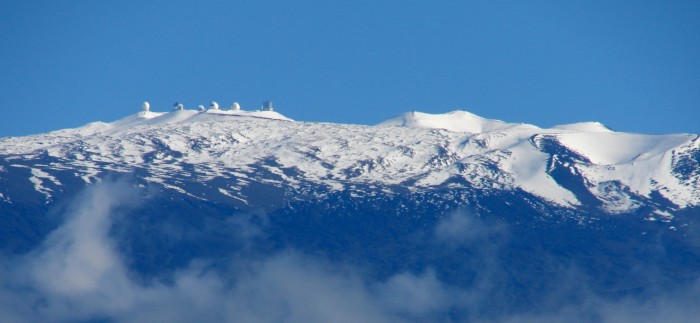
When I say “Mauna Kea” is sacred, I do not mean to use “sacred” the way most people use that term. I mean “sacred” not in the same sense of worship. I use “sacred” in the sense of “precious” and “so important that nothing else counts”—I apply it to those things and people that we care so much about that we would do anything, even flout and break the law, to preserve their existence.
The child of a parent, especially a young child is “sacred” in this sense. So are parents to their children. So are grandparents. Even the family pet is “sacred.” If your house was burning down would you risk your life to go into the burning house to rescue your children, your mother, your grandparents, even your beloved dog or cat? Would you go even if forbidden by first responders, firemen or policemen? Yes, many of us would go without hesitation–without thinking of the consequences. Would you give a kidney to save or extend the life of your child, your brother, your uncle? Would you spend all of your money to save a loved one from cancer? from Lou Gehrig’s disease or from a life in prison without parole? Yes, we all would.
Moreover, we praise such emotions and desires of others who make such sacrifices every day. We understand the soldier who sacrifices himself by instinctively jumping on a grenade. We understand the parent or grandparent who gives all their money to see their child or grandchild through college.
Whether one worships Mauna Kea or not, whether one considers it “sacred” does not matter as much as understanding the instincts that drive those to defend and save Mauna Kea—much as one would understand the absolute love for a child, or a parent even if such acts break the law.
When we see the instinct of family, of brotherhood, of sisterhood of love for mankind in others we celebrate that—we gravitate to that. We love and defend Mauna Kea because it reminds us what makes us human. Sacred is not necessarily a place. It is a relationship, a deep visceral relationship: beyond reason, beyond law, beyond rationality.
The Mauna Kea movement is a movement that has grown because of young people. They live in new confusing world themselves—a world of cognitive dissonance. That is they live within an outright contraction—a Hawaii in decline where there is nothing they can do. They see their world being attacked and destroyed, its water taken, its plants doused with foreign chemicals, its agricultural lands disappear in the name of gentlemen farmers, its open lands used for artillery practice, and its shoreline becoming high-end condominiums that only rich foreigners can afford.

Moreover, to the young, Hawaii is unlivable, there is no viable future: There are no places to rent, no jobs that fit their training, no money for retirement and the endless, life-sapping traffic congestion. And now an eighteen story telescope on Mauna Kea!

It would never be built on other sacred sites: not over the Western Wall, the Dome of the Rock, Angor Wat, Gettysburg, Arlington, or the Arizona Memorial? No one would think of putting a pair of glasses on the eyes of God. Why then, Mauna Kea? We, and our youth are inundated today with the attacks on the treasures of the earth and why?
So, what happened to this “nation” called Hawai‘i, where Mauna Kea was loved and adored? Hawai‘i was a nation, that by a series of events, starting with an overthrow in 1893 and ending with annexation in 1900, by which another nation, the United States, forcefully took the sovereignty of Hawai‘i.
What do I mean by that?—to take one nation’s sovereignty? Sovereignty is the monopoly of a government on the legitimate use of violence.
By that I mean the State, the police and DLNR are the only ones today who can do so-called “legal” violence to Mauna Kea. Similarly, the police of Hawai‘i County and the officers DLNR are the only ones who can use the violence of arrest and jail or fine to force down the protectors of Mauna Kea. Protect the mountain and you go to jail. It is legal. It is called law. It is a power possessed only by the sovereign of a nation. There once was a time in Hawaii when that monopoly on the use of legal power protected not defiled Mauna Kea.
In 1893 and 1900 a new Nation took over in Hawai‘i—a new nation with new rules. These were new rules that had the power to interfere with our very human, emotions and instincts, instincts derived over time from our kupuna, our ancestors and the culture of this nation of Hawai‘i. Hawai‘i has changed.
Today, government has the legitimate power to do violence to families as well. Government agencies can take a child away from a parent. Government agencies can put a Hawaiian in prison for the smallest of offenses—denying him or her freedom and the chance to be with and raise their families. The world of Hawai‘i has been turned upside down.
The answer lies in power, that is law—the shift over their lives by which all is reversed.
In 1898 the United States, by Joint Resolution took the nation of Hawai‘i. I am a legal historian. In the appendix attached I show my work—that concludes definitively that the joint resolution had no such power. It was impotent, it was an act of Congress not a treaty. It could no more take Hawai‘i by a law then Hawai‘i by a law could take America.
It was a fraud—it created a disease that spread, a malaise we all suffer—called the myth of annexation. We all believe we are part of America, we all act as if that were true. We have been taught that way. We follow the lead of others who act that way.
The truth is that the joint resolution did not give to the United States the monopoly on the use of legitimate violence—a violence to build on Mauna Kea, the violence to arrest those who seek to stop that building. Most of all the University claims Mauna Kea by lease—a lease derived from the Joint Resolution.
It is said that the Joint Resolution gave Mauna Kea to the United States, which gave it to the State, which gave it to the University. As a matter of law that is false. It is a lie. The University has no power over Mauna Kea. It cannot build, it cannot give permits, it cannot arrest us.
The mass of young people are here today in protest because we live in a world of cognitive dissonance. They live in a world where they are learning, at the University about the truth of the Joint Resolution, which gives no power, no sovereignty to the state. Outside of their classes they see the State taking what they love—preventing them from running into the burning house to save their Mauna Kea, their father, their sky-father.
And this dissonance makes them ill. It makes our youth sick. It is a crisis that creates mental illness. In short, to build on Mauna Kea is to cast a sickness throughout these islands, a sickness and sadness, not only on Native Hawaiians but on all people who live here.
I have included an appendix, taken from my work, which speaks to the myth of annexation and demonstrates that the Joint Resolution had no capacity to take the Nation of Hawai‘i. I will place this testimony and my appendix on my “Scholar Space” at Hamilton Library, the University of Hawai‘i at Manoa, under my name. This is the link to that site.
Mahalo and Mahalo Ke Akua.
Williamson Chang
Professor of Law



